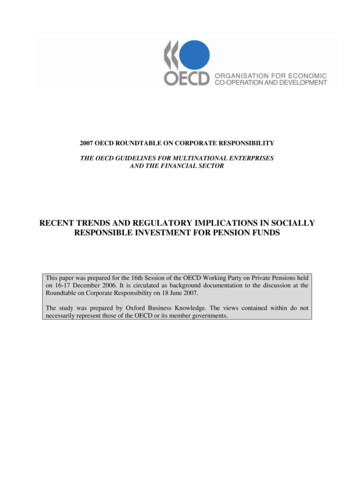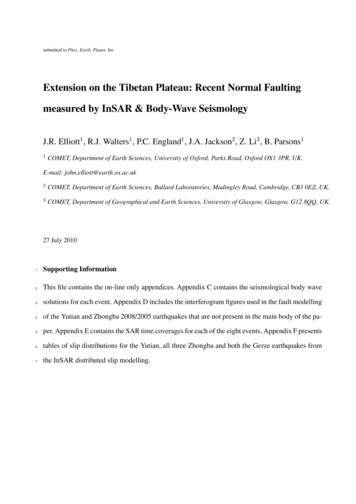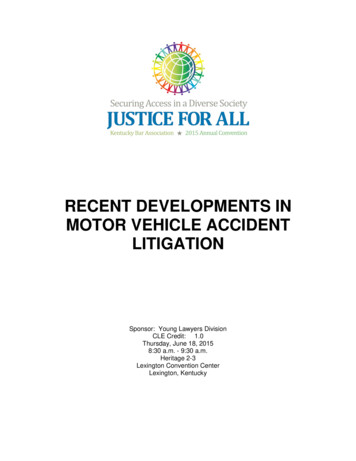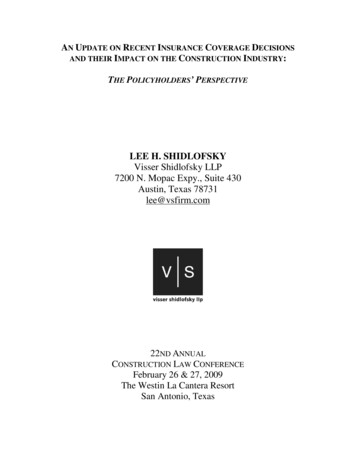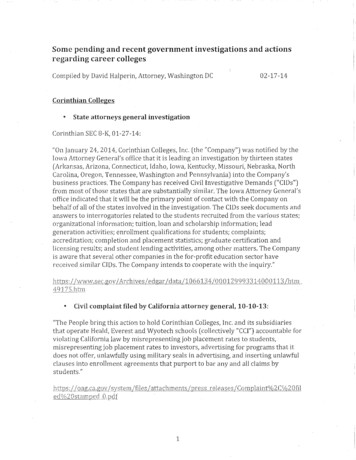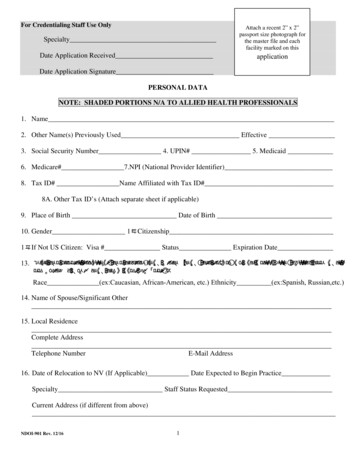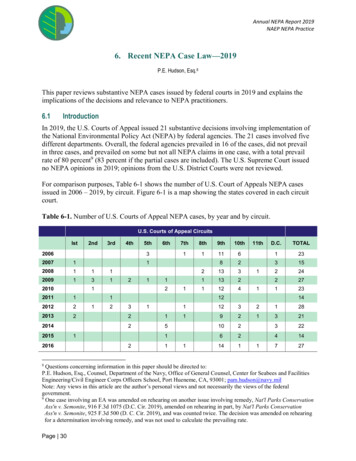
Transcription
Annual NEPA Report 2019NAEP NEPA Practice6. Recent NEPA Case Law—2019P.E. Hudson, Esq.8This paper reviews substantive NEPA cases issued by federal courts in 2019 and explains theimplications of the decisions and relevance to NEPA practitioners.6.1IntroductionIn 2019, the U.S. Courts of Appeal issued 21 substantive decisions involving implementation ofthe National Environmental Policy Act (NEPA) by federal agencies. The 21 cases involved fivedifferent departments. Overall, the federal agencies prevailed in 16 of the cases, did not prevailin three cases, and prevailed on some but not all NEPA claims in one case, with a total prevailrate of 80 percent9 (83 percent if the partial cases are included). The U.S. Supreme Court issuedno NEPA opinions in 2019; opinions from the U.S. District Courts were not reviewed.For comparison purposes, Table 6-1 shows the number of U.S. Court of Appeals NEPA casesissued in 2006 – 2019, by circuit. Figure 6-1 is a map showing the states covered in each circuitcourt.Table 6-1. Number of U.S. Courts of Appeal NEPA cases, by year and by circuit.U.S. Courts of Appeal 11Questions concerning information in this paper should be directed to:P.E. Hudson, Esq., Counsel, Department of the Navy, Office of General Counsel, Center for Seabees and FacilitiesEngineering/Civil Engineer Corps Officers School, Port Hueneme, CA, 93001; pam.hudson@navy.milNote: Any views in this article are the author’s personal views and not necessarily the views of the federalgovernment.9One case involving an EA was amended on rehearing on another issue involving remedy, Nat'l Parks ConservationAss'n v. Semonite, 916 F.3d 1075 (D.C. Cir. 2019), amended on rehearing in part, by Nat'l Parks ConservationAss'n v. Semonite, 925 F.3d 500 (D. C. Cir. 2019), and was counted twice. The decision was amended on rehearingfor a determination involving remedy, and was not used to calculate the prevailing rate.Page 30
Annual NEPA Report 2019NAEP NEPA PracticeU.S. Courts of Appeal %Figure 6-1. Map of U.S. Circuit Courts of Appeal.6.2Statistics and Overview of CasesFederal agencies prevailed in 80 percent (83 percent if the partial cases are included) of thesubstantive NEPA cases brought before the U.S. Courts of Appeal.The U.S. Department of the Agriculture (U.S. Forest Service [USFS]) was involved in sevencases. The U.S. Department of the Interior (Bureau of Land Management [BLM], Bureau ofIndian Affairs [BIA] and National Park Service [NPS]) and U.S. Department of TransportationPage 31
Annual NEPA Report 2019NAEP NEPA Practice[Federal Highway Administration [FHwA] and Federal Aviation Administration [FAA]) wereeach involved in four cases. The Department of Defense (U.S. Army Corps of Engineers[USACE]), and the Federal Energy Regulatory Commission (FERC) were each involved in threecases.The Department of Interior did not prevail in one of its cases, and prevailed in some, but not allof the NEPA claims in another case. The Department of Defense and Department ofTransportation did not prevail in one of their cases.Of the 21 substantive cases, four cases involved a categorical exclusion (CatEx), 10 involvedenvironmental assessments (EAs), and seven involved environmental impact statements (EISs).One case in which the agencies did not prevail involved a CatEx (City of Burien v. Elwell, No.18-71705, 790 Fed. Appx. 857, 2019 WL 6358039 (9th Cir. Nov. 27, 2019) (not forpublication)). Three cases in which the agencies did not prevail or only partially prevailedinvolved EAs: Nat'l Parks Conservation Ass'n v. Semonite, 916 F.3d 1075 (D.C. Cir. 2019);Oregon Natural Desert Ass'n v. Rose, 921 F.3d 1185 (9th Cir. 2019), amended on rehearing inpart, by 925 F.3d 500 (D. C. Cir. 2019); and Diné Citizens Against Ruining our Env't v.Bernhardt, 923 F.3d 831 (10th Cir. 2019, agency partially prevailed). The agencies prevailed inall cases involving an EIS. The agencies prevailed in the other 16 cases.6.3TrendsThe following relates some trends and interesting conclusions from the 2019 substantive cases.Note that there are several cases that were not reported, which means they have no precedentialvalue, depending on the court. However, the rulings can still be of value to NEPA practitioners.Assessment of Impacts: Eighteen of the cases involved one or more challenges to assessment ofimpacts, including cumulative impacts, as well as four CatEx cases. The courts tended to focuson the deference afforded to the agency when they upheld the impact assessment analysis.Categorical Exclusion: Four cases involved application of CatExs to projects. Center for Biological Diversity v. Ilano, 928 F.3d 774 (9th Cir. 2019) (concludingthat the USFS, in applying a CatEx for designation of land areas and in its approval ofa plan to combat the invasive pine bark beetle, considered relevant scientific data,engaged in a careful analysis, and reached its conclusion based on evidence supportedby the record). Wise v. Dep't of Transp., 943 F.3d 1161 (8th Cir. 2019) (upholding agency's decisionto apply a CatEx involving an existing operational right of way for improvementsproposed along I-630, in the City of Little Rock, Arkansas, increasing the travel lanesfrom six to eight and replacing all bridges within the project’s limits). Sauk Prairie Conserv. Alliance v. U.S. Dep't of the Interior, 944 F.3d 644 (7th Cir.2019) (opining the NPS's application of a CatEx for approval of dog training forhunting, and off-road motorcycle riding was adequate because there was enoughPage 32
Annual NEPA Report 2019NAEP NEPA Practiceanalysis in the state's Master Plan and EIS and in the NEPA screening form to supportthe NPS's conclusion that the amendments would have minimal impact). City of Burien v. Elwell, No. 18-71705, 790 Fed. Appx. 857, 2019 WL 6358039 (9thCir. Nov. 27, 2019) (not for publication) (disapproving the application of a CatExinvolving FAA’s approval of a procedure for turning southbound turboprops to thewest at Sea-Tac Airport with instructions to consider the potential cumulative impactof all relevant reasonably foreseeable future actions, such as the Sea-Tac SustainableAirport Market Plan, as part of its extraordinary circumstances analysis).Direct Impacts: Ten cases involved challenges to assessment of direct impacts. Save our Sound OBX, Inc. v. North Carolina Dep't of Transp., 914 F.3d 213 (4th Cir.2019) (finding that the agencies' adequately considered the environmental effects ofconstruction of a bridge replacing a segment of highway on the Outer Banks of NorthCarolina). Nat'l Parks Conservation Ass'n v. Semonite, 916 F.3d 1075 (D.C. Cir. 2019),amended on rehearing in part, by 925 F.3d 500 (D. C. Cir. 2019) (opining that theUSACE's EA and grant of a permit to a utility company to construct a transmissionacross the historically significant St. James River triggered several significancefactors, 40 C.F.R. §1508.27). WildEarth Guardians v. Conner, 920 F.3d 1245 (10th Cir. 2019) (holding that theUSFS adequately assessed the impacts to Canada lynx in an EA involving a project inresponse to the mountain pine beetle epidemic). Oregon Natural Desert Ass'n v. Rose, 921 F.3d 1185 (9th Cir. 2019) (finding thatBLM's issuance of travel management plan failed to establish adequate environmentalbaseline conditions necessary to assess impacts). WildEarth Guardians v. Provencio, 923 F.3d 655 (9th Cir. 2019) (upholding BLM'sissuance of a travel management plan and EA in Kaibab National Forest (NF),Arizona, analyzing several significance factors and finding no significant impact). City of Oberlin, Ohio v. Federal Energy Regulatory Comm'n, 937 F.3d 599 (D.C. Cir.2019) (discussing, in a brief decision, that FERC, in authorizing the construction andoperation of a natural gas pipeline, fulfilled its duty to independently consider thepipeline's safety risks). Protect Our Communities Found. v. LaCounte, 939 F.3d 1029 (9th Cir. 2019)(discussing that the agency's record of decision stated that the EIS “included ananalysis of all environmental issues associated with construction and operation” ofturbines, and therefore did not require more analysis or a supplemental document,even if it never stated that the information was not “significant," citing Great OldBroads for Wilderness v. Kimbell, 709 F.3d 836, 855 (9th Cir. 2013)).Page 33
Annual NEPA Report 2019NAEP NEPA Practice Indian River County, Florida v. U.S. Dep't of the Transp., 945 F.3d 515 (D.C. Cir.2019) (holding Federal Railway Agency's EIS clearly complied with the impactassessment requirements of NEPA). Friend of the Wild Swan v. Kehr, No. 18-35612, 770 Fed. Appx. 351 (Mem) (9th Cir.May 10, 2019) (not for publication) (holding, in a brief decision, that although theUSFS could have done a better job demonstrating its compliance with the elk habitatroad density standards by more precise mapping and explanation that the project metthe Forest Plan's standards, the USFS did just enough to comply with the Forest Planand NEPA). Conservation Congress v. United States Forest Serv., No. 17-16153, 775 Fed. Appx.298 (9th Cir. June 4, 2019) (not for publication) (concurring that the USFS did notviolate NEPA when it assessed the impacts of a plan to administer fuel and vegetativetreatments in Mendocino NF, California in a limited geographic scope).Indirect Impacts: Three cases involved assessment of indirect impacts. Birckhead v. Federal Energy Regulatory Comm'n, 925 F.3d 510 (D.C. Cir. 2019)(considering whether FERC was required to consider upstream and downstream gasproduction (indirect effects) as reasonably foreseeable effects and after discussing inthe opinion, ultimately declining to make a decision since the argument was notpreviously raised in the record). Center for Biological Diversity v. U.S. Army Corps of Eng’rs, 941 F.3d 1288 (11thCir. 2019) (upholding USACE’s issuance of a § 404 permit and EA involvingphosphate mining and finding USACE did not have to consider indirect effects ofcreating and managing phosphogypsum resulting from downstream fertilizerproduction). Appalachian Voices v. Federal Energy Regulatory Comm'n, No. 17-1271,Consolidated with 18-1002, 18-1175, 18-1177, 18-1186, 18-1216, 18-1223, 2019 WL847199 (D. C. Cir. Feb. 19, 2019) (not for publication) (concluding, in a briefopinion, that FERC's estimate of the upper bound of emissions resulting from end-usecombustion was adequate, in light of FERC's explanation that the Social Cost ofCarbon tool is not an appropriate measure of project level climate change impacts ortheir significance).Cumulative Impacts: Four cases involved inadequacy or lack of cumulative impactassessment. Page 34WildEarth Guardians v. Conner, 920 F.3d 1245 (10th Cir. 2019) (opining, in a briefdiscussion, that the USFS's analysis finding the cumulative effects on Canada lynxwere not significant).
Annual NEPA Report 2019NAEP NEPA Practice Diné Citizens Against Ruining our Env't v. Bernhardt, 923 F.3d 831 (10th Cir. 2019)(agreeing that BLM never considered the cumulative impact of the water useassociated with the 3,960 reasonably foreseeable horizontal wells in the MancosShale in New Mexico). City of Burien v. Elwell, No. 18-71705, -- Fed. Appx. ---, 2019 WL 6358039 (9th Cir.Nov. 27, 2019) (not for publication) (disagreeing with the application of a CatExinvolving FAA’s approval of a procedure for turning southbound turboprops to thewest at Sea-Tac Airport with instructions to consider the potential cumulative impactof all relevant reasonably foreseeable future actions, such as the Sea-Tac SustainableAirport Market Plan, as part of its extraordinary circumstances analysis). Alliance for the Wild Rockies v. Savage, No. 19-35035, 783 Fed. Appx. 756 (Mem)(9th Cir. Nov. 4, 2019) (not for publication) (holding, in a brief opinion, that theaggregation of road closures breaches into the environmental baseline was adequate,and the USFS was not required to provide a separate analysis of cumulative impacts).Alternatives Considered: Four cases involved challenges to the sufficiency of the alternativesconsidered: Save our Sound OBX, Inc. v. North Carolina Dep't of Transp., 914 F.3d 213 (4th Cir.2019) (disagreeing that the settlement agreement predetermined the agencies' selectionof alternative, because the settlement only required that the preferred alternative, theJug-Handle bridge, be identified and that the merger team concur; the entire mergerteam was responsible for approving the final alternative, and the parties of thesettlement constituted only 3 of 10 parties on the merger team). Nat'l Parks Conservation Ass'n v. Semonite, 916 F.3d 1075 (D.C. Cir. 2019), amendedon rehearing in part, by 925 F.3d 500 (D. C. Cir. 2019) (taking no position on thealternatives challenge, after finding the impact assessment inadequate, but urgingUSACE to consider its sister agencies' concerns that prior iterations were "superficial,""inadequate," and "extremely problematic."). Protect Our Communities Found. v. LaCounte, 939 F.3d 1029 (9th Cir. 2019)(rejecting suggestion that BIA failed to consider any mid-range alternatives "thatentailed building some but not all of the proposed ridgeline turbines.") Conservation Congress v. United States Forest Serv., No. 17-16153, 775 Fed. Appx.298 (9th Cir. June 4, 2019) (not for publication) (upholding USFS adequately analyzedpotential alternatives for its plan to administer fuel and vegetative treatments to furtherhabitat and fire management goals in the Mendocino NF in Northern California).Federal Action: Two cases involved arguments whether an agency's action qualified as a federalaction.Page 35
Annual NEPA Report 2019NAEP NEPA Practice Center for Biological Diversity v. Ilano, 928 F.3d 774 (9th Cir. 2019) (holding that theUSFS's designation of landscape-scale areas identifying swaths of land suffering fromthe harms of insect or disease infestation did not trigger a NEPA analysis). Sauk Prairie Conserv. Alliance v. U.S. Dep't of the Interior, 944 F.3d 644 (7th Cir.2019) (agreeing that no impact statement was required because the Army conditionedits approval of the land transfer on continued helicopter use, and thus the USFS had nodiscretion over whether to take the proposed action).Duty to Supplement: Three cases involved the duty to or involved challenges to supplementaldocuments. Center for Biological Diversity v. U.S. Army Corps of Eng’rs, 941 F.3d 1288 (11thCir. 2019) (opining that, under 40 C.F.R. § 1502.9, additional information need onlybe accounted for if the information would have been useful to the agency'sdecisionmaking process). Protect Our Communities Found. v. LaCounte, 939 F.3d 1029 (9th Cir. 2019)(rejecting allegations that BIA should have prepared a supplemental EIS to analyzenew information that arose after the EIS was published). Save our Sound OBX, Inc. v. North Carolina Dep't of Transp., 914 F.3d 213 (4th Cir.2019) (discussing that a supplemental EIS is only required when changes to a projectpresent a "seriously different picture of the environmental impact.").6.4Details of CasesEach of the substantive 2019 NEPA cases in U.S. Courts of Appeals, organized by federalagency, is summarized below. Unpublished cases are noted (6 of the 21 substantive cases in2019 were unpublished, with 5 cases from the Ninth Circuit, and 1 case from the D.C. Circuit).Although such cases may not have precedential value depending on the court, they can be ofvalue to NEPA practitioners.U.S. DEPARTMENT OF AGRICULTUREWildEarth Guardians v. Conner, 920 F.3d 1245 (10th Cir. 2019)Agency prevailed.Issues: Proposed Action, Significance of impacts (specific factors discussed), Cumulative ImpactsFacts: WildEarth Guardians (WildEarth) challenged the USFS's preparation of an EA. WildEarth allegedthat the USFS did not adequately assess the effects on Canada lynx resulting from its Tennessee Project(the Project), and should have prepared an EIS. The Project, in the San Isabel and White River NationalForests, was proposed to protect the forests from insects, disease, and fire, improve wildlife habitat, andmaintain watershed conditions.Page 36
Annual NEPA Report 2019NAEP NEPA PracticeThe USFS planned the Project, proposed over a time period of 10 – 15 years, as a response to themountain-pine-beetle epidemic that impacted forest stands on the White River and San Isabel NationalForests and created an associated threat to headwaters that serve communities along Colorado's FrontRange. The Project's goals were to “create forest conditions that are more resilient to outbreaks of insects,disease and wildfire; to improve habitat for threatened, endangered and sensitive species and otherimportant wildlife species; and to provide for sustainable watershed conditions.” The planned actioninvolves a mix of clearcutting, thinning, and prescribed burns. The dominant forest type in the 16,450-acreProject area is lodgepole pine (11,096 acres), although there are also significant spruce-fir stands (2,177acres) and aspen stands (564 acres). The lodgepole pines are currently vulnerable to beetle infestationsand the spread of dwarf mistletoe. In 2014, 40% of the lodgepole-pine stands were already infected bydwarf mistletoe. The spruce-fir and aspen stands were invaded by only a low incidence of insects anddisease, but prevention in the future of the aging trees was of concern to the USFS.In 2013 the USFS issued a draft EA, as well as a draft biological assessment (BA) that primarily analyzedthe Project’s effects on lynx. As a matter of background, the Canada lynx is native to the snowy, highaltitude coniferous forests of Colorado's Southern Rockies. The mountains provide the conditionsnecessary for lynx habitat: elevated forests dominated by spruce-fir, lodgepole pine, and aspen-conifer mix,and populated by snowshoe hare for lynx to prey on. The FWS designated the lynx as a threatened speciesin 2000.In early 2014 the USFS released the final EA and final BA together with a draft FONSI. The final EAexamined three alternatives for treating the Project area, including a no-action alternative. The USFS’schosen alternative involved 2,370 acres of clearcutting, 6,765 acres of thinning, 345 acres of precommercialthinning (a process of thinning stands that were clear-cut 20-30 years earlier, so that growth can beconcentrated on the more commercially valuable trees), and 6,040 acres of prescribed burns (some ofwhich will overlap with the clearcutting and thinning), as well as the creation of about 21 miles of temporaryroads. The EA also described how much those treatments, spaced out over 10 to 15 years, impact eachforest type. The USFS uses clearcutting and prescribed burns to create openings in lodgepole-pine stands,but on no more than 25% of the 9,480 acres of treatable pine, and with clear-cuts limited to irregularlyshaped 40-acre patches. The clear-cuts will “essentially eliminate” the risk of beetle infestation in treatedstands and will allow new stands to regenerate “mistletoe free.” Although the EA quantified the amount ofeach type of treatment, it did not specify the treatment locations. Rather, the USFS intended to identify 300to 500 acres for thinning and clearcutting each year over the next 10 to 15 years. It asserted that this flexibleapproach is necessary for reacting to on-the-ground conditions, such as a beetle infestation or fire risk.The EA included nine pages analyzing the proposed action’s possible effects on lynx, as well as anappendix assessing its adherence to each 2008 Rockies Lynx Amendment (SRLA). The SLRA's purposewas to strike “a reasonable balance in providing for the conservation of lynx habitat while also allowingappropriate levels of human uses to occur.” Because the USFS did no
One case in which the agencies did not prevail involved a CatEx (City of Burien v. Elwell, No. 18-71705, 790 Fed. Appx. 857, 2019 WL 6358039 (9th Cir. Nov. 27, 2019) (not for publication)). Three cases in which the agencies did not prevail or only partially prevailed




